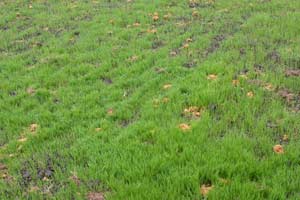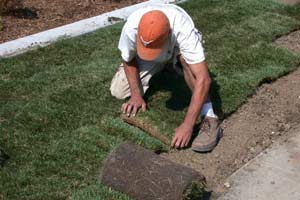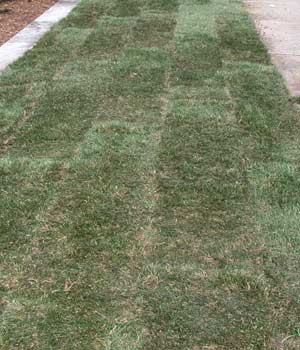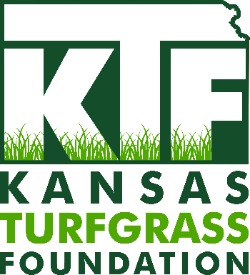Establishment
Careful turfgrass selection is an important first step in establishing, overseeding, or renovating a turfgrass. Many potential problems related to turf use, appearance, environment, insect or disease pests, and cultural practices can be avoided by properly choosing species and cultivars that best fit the situation in which the turfgrass will be grown.
A turfgrass, when planted in areas where it is not adapted, often deteriorates or fails. The result of planting a turfgrass where it is not adapted is a poor-quality turf that requires excessive pesticide applications, fertilization, and replanting to retain a green ground cover. A high-quality turf may not be obtainable in this situation. Detailed information on selecting the right type of turfgrass can be found on the website Turfgrasses for the Midwest.
Following turfgrass selection, planting a lawn entails selecting the method of establishment, properly preparing the planting site, planting the turfgrass, and performing post-planting maintenance. Proper establishment is essential for long-term lawn health and attractive appearance.
Establishment Methods and Timing
Determining the lawn establishment method is an important first step in the establishment process. In the Midwest, lawns are normally established by seeding or sodding; zoysiagrass plugging is also used occasionally.

Seeding is a common method of establishing a lawn, which involves planting grass seed on a prepared seedbed. There are both advantages and disadvantages to seeding a lawn.
The advantages of seeding a lawn are:
- the desired species or cultivars can be used
- the turf plants develop in the environment in which they must ultimately survive
- establishment usually costs less than for sodding or plugging
The disadvantages of seeding a lawn are:
- the appropriate times for establishment are limited
- the turf is usually slow to develop into a quality stand
- reseeding areas with poor germination may be required
- quality seed may be difficult to obtain in some areas
- rain or irrigation may wash seeds off slopes
- weed encroachment is often a problem
- a constantly moist seedbed is required during germination

(above) Sod strips must be laid tightly
together to prevent weed invasion in the gaps
and to produce a smooth lawn.
(below) A properly laid sod lawn will
"knit together" in a short time
and the lines will disappear.

Sodding entails placing squares or strips of growing turfgrass and the adhering soil onto a final planting site. The strips or squares are tightly butted to one another to produce a complete cover of turfgrass. Kentucky bluegrass, creeping bentgrass, zoysiagrass, bermudagrass, buffalograss, and occasionally tall fescue can be established by sodding.
The advantages of sodding a lawn are:
- an "instant" lawn is planted
- sodded lawns can be safely trafficked sooner than seeded lawns
- dust and mud are reduced
- erosion control is achieved
- sod can be planted any time during the growing season (provided the ground is not frozen and water is available)
- good sod is weed free
The disadvantages of sodding a lawn are:
- the cost is higher than for seeding
- choice of turfgrass species and cultivars used in sod production is limited
- sod is not produced in shaded environments
- a large volume of water is required during establishment
- incompatibilities between sod-farm soils and soils at the planting site can cause sod to perform poorly
- sod may shrink, allowing weeds to invade between pieces
- the speed of sod rooting changes with the season
Although it appears there are fewer advantages than disadvantages to seeding a lawn, do not discount the importance of being able to select the desired species or cultivars and the fact that the turf plants develop in the environment in which they must ultimately survive. For example, obtaining perennial ryegrass or fine fescue sod will be difficult, perhaps impossible, in most areas of the region. If these species are desired in the lawn, seeding is the only way to establish them. In addition, soil incompatibility sometimes develops when sod is grown on soil that is different from that of the lawn area. Soil incompatibility can result in poorly rooted sod that has little tolerance to environmental or pest stresses. Thus, in many situations, the advantages of seeding may outweigh the advantages of sodding.
Plugging is sometimes used to establish zoysiagrass in the Midwest. Plugs are 2- to 4-inch-diameter pieces of zoysiagrass with the adhering soil. They are planted 6 to 12 inches apart in a well-prepared planting bed and often take up to 3 years to fully establish and fill in completely.
Seed turfgrass lawns comprised of Kentucky bluegrass, perennial ryegrass, fine fescues, or tall fescue during spring or late summer and early fall. Late summer and early fall is considered to be the best time. In the fall, weed competition is reduced and temperatures are appropriate for rapid turf growth and development. Fall-planted turfgrass seedlings have plenty of time to establish a good root system before the following summer's heat. Spring establishment can also be successful. At this time, however, weed competition, especially from annual weeds, can be particularly troublesome. In addition, it is necessary that adequate irrigation be available during summer's heat.
A cool season lawn can be sodded in the north central region anytime during the growing season provided adequate irrigation water is available. Sodding or plugging a warm season lawn in the north central region is best done in late spring to early summer .
Planting Site Preparation
Proper preparation of the planting site can reduce many soil drainage and aeration, pH, and fertility problems that may not become evident until after the lawn is established. Correcting these problems after the turf is established is much more difficult than preventing their occurrence through proper site preparation, because the presence of the turf can limit your efforts. Thus, this critical step in the establishment process is important to long-term success of a lawn; efforts to provide the best possible soil conditions will not be wasted.
The preparation steps (identical for seeding, sodding, or plugging) are:
- Control weeds at the planting site.
- Rough grade the site and remove debris.
- Conduct soil tests.
- Amend the soil as necessary.
- Work and thoroughly mix the amendments into the soil to a depth of 6 inches.
- Fine grade the site.
Eliminating weeds, especially perennial grassy weeds, will reduce competition with developing turfgrasses. Herbicides are valuable for eliminating weeds prior to lawn establishment. Consult the Cooperative Extension Service for a current list of recommended lawn care chemicals.
After eliminating weeds from the site, rough grade the area to facilitate surface drainage. Generally, a 1 to 2 percent slope (a drop of 1 or 2 feet for every 100 feet of run) away from buildings is adequate. Remove all debris brought to the surface by rough grading. Debris may include tree roots, stones, and leftover materials from construction.
If topsoil is needed at the planting site, incorporate it into the existing soil during rough grading. Avoid using topsoil taken from sites that have recently been treated with agricultural herbicides; these herbicides can be detrimental to turfgrass establishment.
Soil testing provides a valuable means to determine if soils can support turf growth. For a small fee, commercial testing laboratories will evaluate soil pH, phosphorus, and potassium levels in a basic test. In addition, many other soil fertility and textural tests are available at an additional cost. Recommendations for corrective measures are also offered by many soil test laboratories.
Amending heavy, clay soils or light, sandy soils with generous amounts of organic matter can improve the soil's drainage, aeration, and nutrient-holding capacity. If possible, apply a 2-inch layer of sphagnum peat moss, manure, compost, or some other quality organic material to your soil's surface. Use well-rotted organic matter to avoid problems with weed seeds, diseases, or other factors that can inhibit or detract from turf growth and development.
Work the amended soil to a depth of 6 to 8 inches using a rotary tiller. This operation will uniformly incorporate all amendments. After rotary tilling, the soil particles should be marble sized or smaller.
Finally, fine grade the site until it is smooth. Eliminate depressions that may collect moisture. Be sure that the slope away from buildings is 1 to 2 percent. Upon finishing this step, you are ready for seeding, sodding, or plugging your lawn.
Planting
Seeding
The seed label will provide valuable information about grass seed. Information on the label includes the name(s) of the turfgrass species and cultivars present in the package, seed purity, seed germination percentage, crop seed content, amount of inert matter, weed seed content, lot number, and last testing date. In general, select high-quality seed of turfgrass cultivars recommended by the Cooperative Extension Service in your area (see about NCR-192 for links to local extension sites or Turfgrasses for the Midwest). Record the seed lot number in case there are problems with the seed. This information will assist the vendor or producer to solve problems with seed should they arise.
Look for high purity and germination percentage (Table 1), fresh seed (produced the previous year), and low weed seed content (as low as possible ). Avoid buying unlabeled seed. The cost of good grass seed is a small price to pay for a high-quality lawn.
Table 1. Recommended minimum seed purity and germination percentages
| Turfgrass | Purity (%) | Germination (%) |
|---|---|---|
| Kentucky Bluegrass | 90-95 | 75-80 |
| Perennial Ryegrass | 95-98 | 90-95 |
| Tall Fescue | 85-90 | 80-85 |
| Fine-Leaf Fescues | 95-97 | 80-85 |
| Rough Bluegrass | 90-95 | 80-85 |
| Buffalograss | 85-90 | 60-70 |
NOTE: Zoysiagrass and bermudagrass are commonly established by sodding or plugging, so they are not included in this table.
Providing enough seed to insure adequate coverage is important to seeding success, especially for grasses with a bunch growth habit (Table 2). For lawn establishment using cool season species, provide a minimum of 10 to 20 seeds per square inch. Every seed will not produce a grass plant; a healthy, mature lawn usually averages six to eight turf plants per square inch.
Different turfgrasses have different seeding rates. These rates vary according to the size and weight of turfgrass seed. For instance, Kentucky bluegrass has a small seed and a high seed count per pound. On the other hand, perennial ryegrass has a large seed and a lower count per pound. Avoid excessive seeding rates that can produce crowded, weak, unthrifty plants and increase seedling disease invasion. In addition, excessive seeding wastes seed and money.
Table 2. Recommended turfgrass seeding rates
| Turfgrass species | Seeding rate (lb/1000 sq ft) |
|---|---|
| Kentucky Bluegrass | 1 to 3 |
| Perennial Ryegrass | 3 to 5 |
| Tall Fescue Blends | 6 to 9 |
| Fine-Leaf Fescues | 3 to 5 |
| Buffalograss | 1 to 2.5 |
| Mixes | |
|---|---|
| Kentucky Bluegrass/Perennial Ryegrass (80%/20% by weight) | 3 to 4 |
| Kentucky Bluegrass/Fine-Leaf Fescues (50%/50% or 30%/70% by weight) | 3 to 5 |
| 70% or more Rough Bluegrass + remainder in blend of shade-tolerant Kentucky Bluegrasses | 2 to 4 |
After choosing the turfgrass and determining the seeding rate, be sure to distribute the seed uniformly over the planting area. Use a broadcast or drop spreader. It is advisable to apply half the seed in one direction, such as north to south, and then the other half in a different direction, such as east to west, to uniformly cover the entire area.
After the seed is in place, there are two activities that are crucial to successful turf establishment. The first is making sure there is a good seed-to-soil contact. Accomplish this task by using a lawn rake to lightly mix the seed into the upper 1/4 inch of soil.
Follow the raking with a light rolling to produce a firm seed bed. A light rolling can be accomplished by using an empty water-ballast roller. Rolling not only increases seed-to-soil contact, but firms the seedbed and slows drying of the soil.
Mulch with a thin layer of clean straw to prevent drying. Don't apply mulch heavily; you should be able to see soil beneath it. Usually 35 to 50 pounds per 1000 square feet (about one bale) is adequate. You do not have to remove the straw after the grass seed germinates. Grass seedlings will grow up through the light straw layer and gradually cover it as the straw decomposes. Raking off the straw would injure the young grass seedlings.
The second activity crucial to seed establishment success is to make sure adequate water is available throughout the germination process. At the time of planting, irrigate frequently and lightly, wetting the upper 1/2 inch of soil. Continue watering during the period of germination. Water less frequently, but more thoroughly and deeply, as grass seedlings mature.
Average germination times (Table 3) vary according to the turfgrass species and the conditions under which germination takes place. Soil temperatures between 60° and 85°F for cool season grasses and 70° and 90°F for warm season grasses, along with a constantly moist seed bed, result in the quickest germination.
Table 3. Average germination time for various turfgrasses
| Turfgrass species | Average germination time (in days) under ideal growing conditions |
|---|---|
| Kentucky Bluegrass | 10 to 30 |
| Perennial Ryegrass | 3 to 10 |
| Tall Fescue Blends | 7 to 14 |
| Fine-Leaf Fescues | 7 to 14 |
Sodding
If possible, choose sod grown on soils similar to the soils of the planting site or the sod may not "knit" to the soil properly and will gradually decline due to shallow rooting. Be sure to select fresh, healthy sod from a reputable dealer, and plant immediately after purchase. Sod often comes in 18-inch-wide strips that are 6 feet long. Look for sod with a thin soil layer-it will root faster and be easier to install due to its lighter weight. Most sod is harvested at a soil depth of 1/4 to 1/2 inch.
Plant sod in a bricklike pattern with sod edges tightly butting up to one another. Do not stretch sod-it will shrink as it dries allowing weed invasion between pieces. On slopes it may be necessary to use small wooden pegs to help keep sod in place until it roots. Under good conditions sod will begin to root within 14 days. Avoid planting sod on excessively dry soils.
Using a lightweight roller, roll sod immediately after laying to insure close soil contact. Initially irrigate heavily to make sure water penetrates beneath the freshly installed sod and wets the soil. Until sod is established, continue to irrigate frequently, making sure soil is dampened to encourage root development.
Post-Planting Care
Seeded lawns — When new seedlings have reached a height of 2 inches, they may benefit from a fertilizer application. Apply 1/2 pound of nitrogen per 1,000 square feet (if applying 10-10-10, use 5 pounds per 1,000 square feet). Water thoroughly after fertilizing. Begin mowing as turf grows using the "one-third rule," that is, never remove more than one-third of the grass blades at any mowing. For instance, most of the cool season lawn grasses should be maintained at 2 to 3 inches. Mow these grasses when they reach 3 to 4.5 inches.
Limit heavy trafficking during the first growing season. The tender grass seedlings are subject to damage and frequently irrigated soils are easily compacted.
It may be necessary to control annual grassy weeds in spring seedings. Only one preemergence herbicide, Tupersan (siduron), can be safely applied to control these weeds at planting time. It is part of some weed and feed products containing starter fertilizer.
Postemergence broadleaf herbicide applications should not be made to new turf until it has been mowed at least three times. If portions of a lawn need to be reseeded after herbicide applications, wait at least 30 days. Be sure to read, understand, and follow the label instructions.
Sodded Lawns — Fertilize sod using a normal fertilization schedule. For instance, if you install sod in July and your normal fertilization schedule is May, June, September, and November, the first fertilization for the sod would be in September.
Mow the new sod at the desired height using the "one-third rule": when the grass needs cutting, remove no more than one-third of the height in a single mowing.
After the sod has knit down to the soil, core aerification can help turf develop an increased number of deeper growing roots. Core aerify Kentucky bluegrass sod in the spring or fall following installation. Zoysiagrass sod can be core aerified early in the summer following planting.
Whether you establish a lawn by seed, sod, or plugs, the preparation steps are the same. Perennial weeds should be eliminated, the area should be graded, the soil should be amended and smoothed, and the best available turfgrass should be chosen for your specific needs. Then the guidelines for seeding and sodding should be followed. The final requirement is to provide adequate moisture for good establishment of the turfgrass. By establishing a healthy, vigorous turf on a properly prepared site, you will be well on your way to having an attractive lawn.



